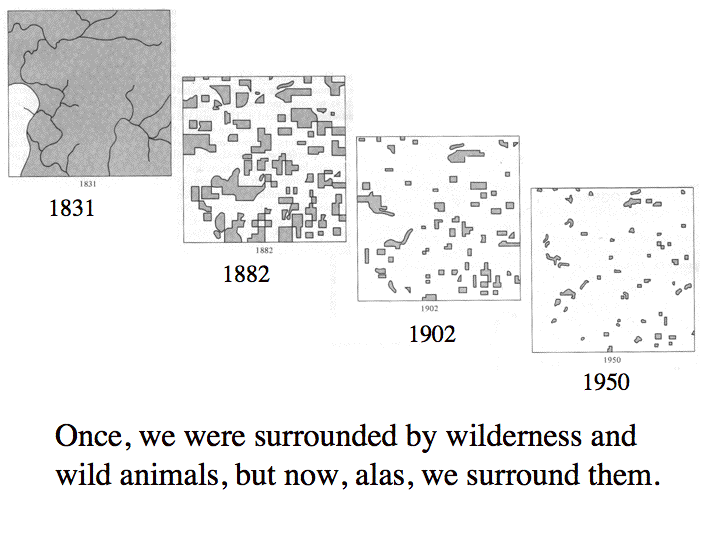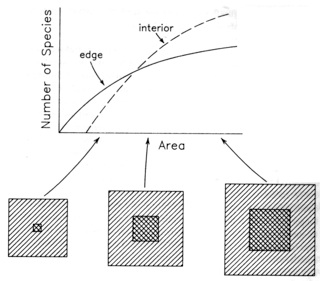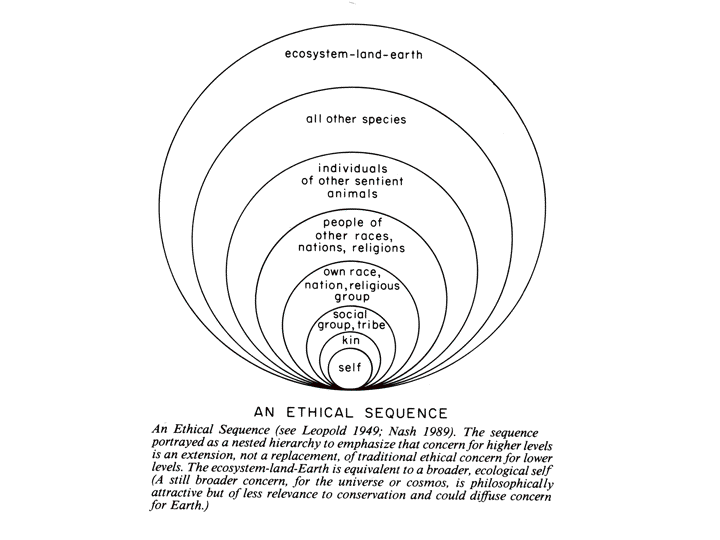
Conservation Biology © Eric R. Pianka "Once humans were surrounded by wilderness and wild animals, but now we surround them." Urbanization and habitat destruction have reduced populations of almost all non-human species, some to the critical point of near extinction. Optimal yield to maximize sustained harvests has long been a goal in wildlife management and fisheries biology. Even so, we have overfished the oceans. Conservation biologists seek to conserve natural habitats and to maintain biotic diversity. Biodiversity constitutes a valuable resource worthy of preservation for many different reasons. Consider some anthropocentric ones. Genetic strains of plants with natural resistance to pests are valuable to humans because their genes can be exploited to confer resistance on future crop plants. Approximately one drug in four originated in a rain forest: these include analgesics, diuretics, laxatives, tranquilizers, contraceptive pills, and cough drops. Antibiotics were first discovered in fungi, but have now also been found in many species of plants as well. Secondary chemicals of plants have proven to be a vast reservoir for useful pharmaceutical products. Clinically proven drugs derived from higher plants include: aspirin, morphine, codeine, atropine, quinine, digitalis, and many others. Bark of Pacific yew trees contains taxol, which has proven to be an effective agent for the treatment of certain ovarian cancers. To date, scientists have examined only about one percent of existing plant species for useful pharmaceuticals. Biodiversity is not distributed evenly across earth's surface: only 2% of earth (so-called "hot spots") support almost half the species currently extant (Myers 1988, 1990; Mittermeier et al. 1998). Most of these areas are in the tropics, many in southeast Asia where humans are rapidly encroaching on natural habitats. In conservation biology, a debate has arisen about whether it is better to have a single large nature reserve or several small reserves (the so-called SLOSS debate (Tjørve 2010). Because a single large reserve will support only one population, if this should go extinct that species will be lost; whereas with several smaller reserves, if a population goes extinct in one, it can still re-invade and re-establish itself from another reserve. Conservation biologists also attempt to estimate the minimum viable population size for endangered species. A minimum viable population is the threshold population size for persistence, one that is just large enough to minimize the probability of extinction from all forms of stochasticity (genetic, demographic, and environmental) over a reasonably long period of time. When a population is reduced to a very small size, it must go through a genetic bottleneck, which can greatly reduce genetic variability. Conservation biologists often study the genetics of small populations. Demographic stochasticity involves sequences of births and deaths: if three births occur during a time interval with only two deaths, the population increases, whereas if more deaths occur than births, it decreases. A small population can random walk itself to extinction. A population viability analysis assesses the current status of a species and systematically determines conservation measures needed to prevent its extinction including identification of vulnerable age classes that require protection for persistence of endangered species. Estimates of demographic parameters can be subjected to a sensitivity analysis to determine effects of changes in survivorship of various age classes on the rate of growth of a population (Wisdom and Miles 1997). Recognition and management of endangered species Restoration ecology Ecosystem conservation Ecological economics Environmental ethics Value of Biodiversity Design of Nature Reserves Minimum viable population size Genetic bottlenecks Population viability analysis Sensitivity analyses of Leslie matrices Here is a short list of some things conservation biologists are concerned with -- they design nature reserves, identify endangered species, help to prevent plants and animals that are teetering on the edge of extinction from going extinct, and all sorts of other things. And his is well funded in large parts of the world -- but this is not basic ecology -- it is applied ecology. It's not reading the vanishing book, it's simply aimed at trying to save what little is left. Money has to be spent on that. Nature reserves are only temporary holding places, as witnessed by the continuing onslaught by big oil on the Arctic National Wildlife Refuge. I cannot discuss all the things that concern conservation biologists but I do want to point out one that it is kind of pathetic: we have settled on the minimum viable population size -- how low can you go and still have something -- to me, this is tragic. For many species, combined effects of habitat loss, habitat fragmentation, small population size, genetic and demographic stochasticity, toxic pollution, and climatic changes are overwhelming -- Gilpin and Soulé (1986) call the resulting situation an "extinction vortex" which, like a whirlpool, seems to conspire to pull many existing populations down to precariously low densities or even actual extinction. Tall grass prairie covered hundreds of thousands of square kilometers in the midwestern United States just a few hundred years ago; today, this natural community has virtually disappeared. No one knows what grasslands in California were like a few centuries ago -- hundreds of species of introduced Mediterranen grasses have largely replaced the original native California grasses. Lowland tropical rain forest is now being destroyed at an alarming rate. Natural communities of all sorts are rapidly being replaced by overgrazed pastures, eroded fields, artificial lakes, golf courses, roads, parking lots, shopping malls, and housing developments. None of the earth's natural communities remain pristine; all have been disturbed either with pesticides and other pollutants or by way of introductions and extinctions of species. Even the disturbed remnants of the earth's biomes are continually being broken up into smaller and smaller isolated patches or habitat islands. of species. 
Changes in the landscape in Wisconsin from pre-settlement in 1831 over the course of a century plus. Fragmentation of the once extensive forest has led to many tiny islands of habitat. 
As patch size diminishes, interior habitat decreases faster than edge Habitat, allowing brood parasitic cowbirds greater access to nests of host species in smaller fragments of habitat. 
This figure shows an ethical sequence based on Aldo Leopold's ideas. Here you can see what you're really familiar with at the bottom: Your own selfish self -- you take care of your money, you take care of your possessions, and maybe you're a little bit altruistic towards your kids, brothers, sisters, uncles and aunts. If we went back 10,000 years to when we were still living in a cave, we'd have these little social groups -- tribes -- where everybody knew everybody, and we met in caves that were like this room where older individuals told stories and younger individuals learned from them. And there was some degree of altruism and respect, mutual respect there. Now we're up to the point where we have a nation with political and religious groups and Americans are deadlocked in a stalemate. We have a hopeless 50-50 split right down the middle between Democrats and Republicans. Let's go out a little bit further and think about people of other [races] and other nations. We're not doing very well dealing with Muslims and mid-easterners, are we? What about other sentient animals? Our closest relatives are chimpanzees and gorillas. It has recently been shown that they feel empathy {de Waal, 2014 #109}. We don't treat them very well. In Africa, they're hunting gorillas, which are on the edge of extinction, and eating them -- they call it "bush meat." We subject chimps to all kinds of things in labs to create pharmaceuticals that can help humans. How we would feel if natural selection had taken a different route than it has and if in fact chimps or gorillas or both of them were superior to us and treated us the way we treat them? We'd be the ones in cages! I think that would be fair. And finally, let's keep going out and consider all other species -- and then the whole earth. The point here is that everything is focused on ourselves. And we can't, or at least we don't seem to be able to move out from our selfish self-interests (anthropocentrism). Aldo Leopold (1949) was a voice crying in the wilderness, one that's been widely ignored by everybody. Last updated 3 September 2014 by Eric R. Pianka |